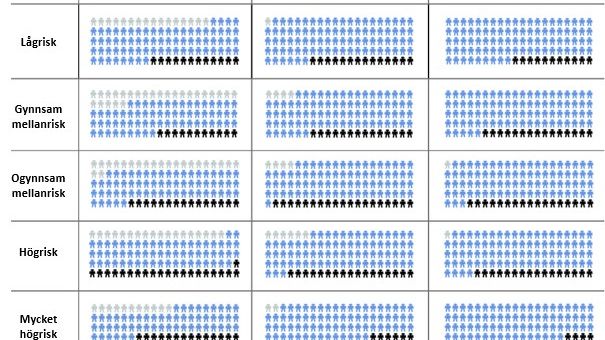
Press release -
Good prognosis for men with prostate cancer treated according to guidelines
Most men who are treated for prostate cancer according to modern guidelines have good survival rates and the majority of these men will die of causes other than prostate cancer. This is revealed in a new study from Uppsala University published in the Journal of the National Comprehensive Cancer Network.
Peer-review / Observational study / People
“We were surprised by how much life expectancy affected the prognosis. This shows the importance of a thorough assessment of the general health of a man with newly diagnosed prostate cancer. The patient’s life expectancy has a substantial impact on the choice of appropriate treatment strategy,” says Marcus Westerberg, researcher at the Department of Surgical Sciences at Uppsala University, who led the study.
In prostate cancer, the disease progression often takes decades and the risk of dying from prostate cancer therefore depends on both the characteristics of the cancer and life expectancy based on the man’s age and other diseases at the time of diagnosis. Recommendations in guidelines and care programmes are therefore also based on both cancer characteristics and life expectancy. This means that the recommended initial treatment can range from active monitoring for low-risk cancer to combinations of local and systemic treatment for high-risk cancer.
High average age at disease onset
As the average age at diagnosis of prostate cancer is often high and the cancer often progresses very slowly, it is particularly important to know the long-term risk of death from prostate cancer in order to choose the best treatment for patients. Previously, not much has been known about this.
“We wanted to fill that knowledge gap, so we looked at outcomes up to 30 years after the men were diagnosed. In all cases, we had information about the characteristics of the cancer, treatment and the patient’s life expectancy based on age and comorbidity,” says Westerberg.
The researchers used data from the Prostate Cancer Database Sweden (PCBase), which contains information from the National Prostate Cancer Register (NPCR) and other health data registers. They focused on men who had received the recommended treatment for prostate cancer that had not spread in the body. Using statistical modelling, the researchers estimated the lifetime risk of dying from prostate cancer and other causes.
11 per cent risk of dying of cancer
For men with low-risk cancer and short life expectancy (less than 10 years), the risk of dying from prostate cancer was 11 per cent and the risk of dying from other causes was 89 per cent within 30 years of diagnosis.
For men with high-risk cancer (e.g. stage T3, PSA 30 ng/ml and Gleason score 8) and long life expectancy (over 15 years), the risk of dying from prostate cancer was 34 per cent and the risk of dying from other causes was 55 per cent within 30 years of diagnosis.
“We hope that our results will be used to provide a realistic picture of the prognosis for men with prostate cancer. Our study shows that most men who receive the recommended treatment have a good prognosis,” Westerberg concludes.
Life expectancy was based on age and comorbidity. Examples of low-risk cancers are stage T1, PSA 5 ng/ml and Gleason score 6. Examples of high-risk cancers are stage T3, PSA 30 ng/ml and Gleason score 8.
Reference: Scilipoti, P., Bratt, O., Garmo, H., Wilberg Orrason, A., Gedeborg, R. Long-term outcomes after guideline-recommended treatment of men with prostate cancer. Journal of the National Comprehensive Cancer Network. 2025. DOI 10.6004/jnccn.2025.7022
For more information, please contact:
Marcus Westerberg, Department of Surgical Sciences, Uppsala University, e-mail: marcus.westerberg@uu.se
The research is funded by the Swedish Cancer Society, the Swedish Research Council and Region Uppsala.
Facts
National Prostate Cancer Register (NPCR) and Prostate Cancer Database Sweden (PCBase)
The NPCR contains thorough characterisation of cancer and primary treatment for 98 per cent of all men with prostate cancer in Sweden. The ultimate aim of the NPCR is to ensure that all men with prostate cancer receive the right treatment at the right time. In PCBase, the NPCR has been enriched with data from the National Patient Register, the National Prescribed Drug Register and the National Cause of Death Register, among others.
In Sweden, a care programme for prostate cancer is used and updated annually. The recommendations of the care programme are very much in line with those of international guidelines, such as the National Comprehensive Cancer Network (NCCN). The study used the NCCN categorisation of cancer characteristics and recommended treatments to make the study internationally viable, and life expectancy was calculated based on age and comorbidities.
Link to care programme (Swedish)
Caption, figure below:Risk of death and cause of death 30 years after diagnosis as a proportion of 100 men.
Grey figures indicate the proportion of men alive after 30 years, blue figures the proportion of men who died of other causes, and black figures the proportion of men who died of prostate cancer.
Topics
Categories
Founded in 1477, Uppsala University is the oldest university in Sweden. With more than 50,000 students and 7,500 employees in Uppsala and Visby, we are a broad university with research in social sciences, humanities, technology, natural sciences, medicine and pharmacology. Our mission is to conduct education and research of the highest quality and relevance to society on a long-term basis. Uppsala University is regularly ranked among the world’s top universities. www.uu.se


